.

Epidaurus Theater, designed by Polykleitos, c. 330 BC, 14000 seats at a sacread area of Asklepios [ Source]
Greek theatre or Greek Drama is a theatrical tradition that flourished in ancient Greece between c. 600 and c. 200 BC. The polis of Athens, the political and military power in Greece during this period, was the epicenter of ancient Greek theatre. Athenian tragedy, comedy, and satyr plays were some of the earliest theatrical forms to emerge in the world. Greek theatre and plays have had a lasting impact on Western drama and culture.
Origins
Early tradition holds that formall theatre in Athens evolved from festivals related to the cult of Dionysus, the Greek god of fertility and wine. This tradition is probably accurate, since Athenian drama occurred at the Dionysia, an annual festival honoring Dionysus. However, it is impossible to know for sure how fertility rituals developed into tragedy and comedy.
Aristotle's Poetics says that Greek tragedy came about earlier than the satyr plays and comedies. He says that tragedy grew out of dithyrambs, songs sung in praise of Dionysus at the Dionysia each year. The dithyrambs began as frenzied improvisations. In the 600s BC, the poet Arion is credited with developing the dithyramb into a formalized narrative sung by a chorus. Then in 534 BC, a man named Thespis is credited with playing the role of the main character in a narrative. He spoke and acted as if he were the character, and he interacted with the chorus, who acted as narrators and commentators. Thespis is therefore considered the first Greek "actor."
Golden Age
By the fifth century BC, theatre had become formalized and was a major part of Athenian culture and civic pride. The centerpiece of the annual Dionysia was a competition among three playwritghts at the Theatre of Dionysus. Each submitted a trilogy of connected tragedies, plus a satyr play that dealt with the same subject matter as the tragedies, but in a lighthearted way. By this time, plays featured two actors instead of one, and the chorus functioned as a separate character rather than a narrator (see Greek chorus). In addition, the subject matter of the plays had expanded so that rather than just Dionysus, they treated the whole body of Greek mythology.
Also during this period, Greek theatre spread outside of Athens. Athens' Dionysia remained the most important theatrical event in Greece, but every major Greek city built itself a theatre. The best-preserved one is in Epidaurus. Greek theatre in every city probably kept its connection with religious festivals and mythology.
Only four playwrights from this period have complete plays that survive extant. All are from Athens. They are the tragic writers Aeschylus, Sophocles (who added a third actor to his plays), and Euripides and the comic writer Aristophanes. Their plays, along with some secondary sources such as Aristotle, are the basis of what is known about Greek theatre.
Hellenistic period
Athens' power declined following the Peloponnesian War, and its theatrical traditions seem to have lost their vitality. However, Greek theatre continued into the Hellenistic period, following Alexander the Great's conquests in the fourth century BC. The primary Hellenistic theatrical form was New Comedy. The only extant playwright from the period is Menander. One of New Comedy's most important contributions was its influence on Roman comedy, such as the surviving works of Plautus and Terence.
Characteristics
Writing
Aristotle described Greek theatre as adhering to "Three Unities:" unity of time, unity of place, and unity of action. Greek plays normally took place in a single day, happened at a single location, and had one plot line without any subplots. Aristotle meant his Three Unities to be a description of the norm, not a prescription of an ideal. Not all Greek plays adhere rigidly to the Unities, but most come close.
Tragedy and comedy were viewed as completely separate genres, and no plays ever merged aspects of the two. Satyr plays dealt with the mythological subject matter of the tragedies, but in a purely comedic manner.
Architecture
A Greek theater building, or theatron, was a large open-air structure consisting of three parts: the orchestra, the skene, and the audience. At the center was the orchestra, or "dancing place." It was a large circular area about 150 meters across. The orchestra was the place of the action, the choral performances, and the religious rites. An altar was in the middle of the orchestra; in Athens the altar was dedicated to Dionysus.
Behind the orchestra circle was a large rectangular building called the skene, meaning tent or hut. It was used as a "backstage" area where actors could change their costumes and masks. Typically there were three doors between the skene and the orchestra. In front of the skene there may have been a raised acting area called the proskene, the ancestor of the modern proscenium stage. At first, the skene was a literal tent, put up for the religious festival and taken down when it was finished. Later on, theatres included permanent structures to serve as the skene. These structures sometimes were painted to serve as backdrops; hence the English word scenery.
Rising from the circle of the orchestra was the audience. The audience sat on tiers of benches built up on the side of a hill. Greek theatres, then, could only be built on hills that were correctly shaped. A typical theatre was enormous, able to seat 15,000 viewers.
Greek theatres were not enclosed; the audience could see each other and the surrounding countryside as well as the actors and chorus.
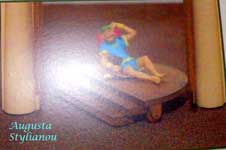
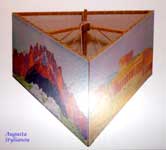
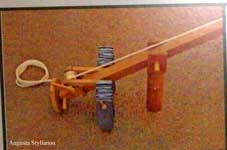
Periaktoi , God "from the machine",
Acting
With such a large space to fill, ancient Greek actors could not be subtle in their acting. They had to bellow loudly and gesture grandly so that the entire audience could see and hear the story. The size of the theatron also precluded the use of most props; actors used pantomime to indicate objects. The convention of plays having only two or three actors meant that an actor had to play more than one character. Often, characters had to be portrayed by more than one actor.
Greek plays incorporated song, chant, and dance. Both the chorus and the characters spoke or chanted in verse set to musical accompaniment.
Costumes and masks
The actors were so far away from the audience that without the aid of exaggerated costumes and masks, they would be difficult to see. Actors wore thick boots to add to their height and gloves to exaggerate their hands so that their movements would be discernable to the audience.
The mask is the best-known symbol of Greek theatre. A distinctive mask was made for each character in a play. The masks were made of linen or cork, so none have survived. We know what they looked like from statues and paintings of ancient Greek actors. Tragic masks carried mournful or pained expressions, while comic masks were smiling or leering. An actor's entire head was covered by his mask, which included hair. It has been theorized that the shape of the mask amplified the actor's voice, making his words easier for the audience to hear.
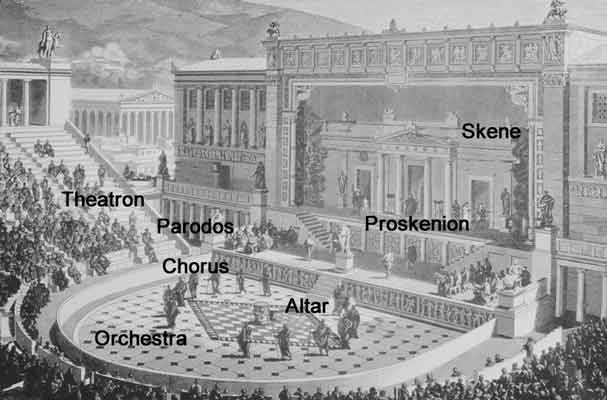
Archon : Official of the city in charge of organizing the festival
Choregos: A citizen in charge of financing and organizing the training of a chorus ( 12-15 "choreutes", dancers )
Chorodidaskalos: Chorus Director
Deus ex machina: "god from the machine" now describing an unexpected solution for some in a hopeless situation
Hypocrit: Actor
Koryphaios: Leader of the Chorus
Kothornoi: Boots used by the actors
Mechane: Crane used for lifting actors (Deux ex Machina)
Odeon: Building adjacent to the theater
Orchestra: Place of the action, the choral performances, and the religious rite (dancing place "orchesis")
Onkos: A Mask with a high head piece
Parodos. Entrance to the Orchestra
Periaktos a device used for displaying and rapidly changing theatre scenes
Program: First day comedies, The next three days three tragedies and one satyr play
Prohedria: Stone seats
Proskenion: Building before the Skene
Protagonist: The star of the play (Thespis) (second and third actor : deuteragonist (Aeschylus), tritagonist (Sophocles))
Skene: Building at rear of stage
Theatron: Embankment (spectator seating area, divided in sections (wedges) "kekrides" )
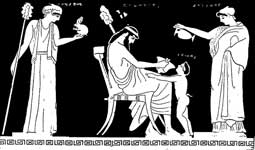
Dionysus with Komos and Tragedy
Quotations
"Οταν βρεθώ στο κοχύλι ενός αρχαίου θεάτρου κοιτάζω το τοπίο, πέρα, πάντα τόσο καλά διαλεγμένο και αμέσως έπειτα ψάχνω τριγύρω μου τους θεατές, προσπαθώ να δω τα μάτια τους, χιλιάδες μάτια, σειρές. Καρφωμένα σε μία λεπτομέρεια, σε μία στιγμή που δεν κληρονομιέται. Όχι σε μία συγκεκριμένη δράση που θα μπορούσα εύκολα να υποθέσω... Τα μάτια σβήνουν μαζί με τη συγκίνησή τους, όπως πεθαίνουν τα άστρα και μένει τούτο το άδειο Διάστημα, τόση ερημιά!..." Γ. Σεφέρης, "Μέρες", Δευτέρα 26 Ιουνίου 1950 Στρατονίκεια Αντιόχου Σωτήρος (from a Greek Website): When I find myself in the shell of an ancient theatre I look at the landscape, beyond, always so much well chosen and immediately then I look around the spectators. I try to see their eyes, thousands eyes in line. Looking at a detail, at a a moment which cannot be transmitted to others. Not at a concrete action that I could easily suppose... The eyes extinguish with their emotions, as stars die and what remains is the empty space, so much desertness. G. Seferis
William Randolph Hearst , a Greek Theater in the United States (History PDF, 7MB)
| Ancient Greece
Science, Technology , Medicine , Warfare, , Biographies , Life , Cities/Places/Maps , Arts , Literature , Philosophy ,Olympics, Mythology , History , Images Medieval Greece / Byzantine Empire Science, Technology, Arts, , Warfare , Literature, Biographies, Icons, History Modern Greece Cities, Islands, Regions, Fauna/Flora ,Biographies , History , Warfare, Science/Technology, Literature, Music , Arts , Film/Actors , Sport , Fashion --- |
Retrieved from "http://en.wikipedia.org"
All text is available under the terms of the GNU Free Documentation License

